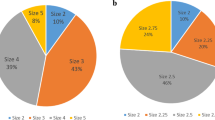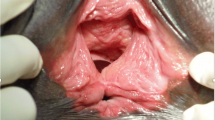Abstract
Introduction and hypothesis
The aim of this study was to identify which factors are associated with anatomic and symptomatic prolapse recurrence in the anterior compartment 1 year after traditional anterior vaginal repair. Our study hypothesis was that major defects in pelvic floor support structures before surgery are associated with higher recurrence rates.
Methods
This was a prospective multicenter study including women with symptomatic anterior compartment prolapse who underwent primary vaginal surgery. Prolapse examination was performed using the Pelvic Organ Prolapse Quantification (POP-Q) system, prolapse symptoms were described using the Pelvic Floor Distress Inventory short form (PFDI-20), and levator ani avulsion and hiatal area were identified by translabial 3D ultrasonography.
Results
During the inclusion period, 455 patients were recruited and 442 (97.1%) attended the 1-year follow-up. In three cases, ultrasound data were not available, and the remaining 439 formed the study group. Anatomic and symptomatic recurrence rates were 45.1% and 6.8%, respectively. Levator avulsion increased the risk of anatomic (OR: 1.96) and symptomatic (OR: 2.60) recurrence; abnormal distensibility of the levator hiatal area increased the risk of anatomic (OR: 2.51) and symptomatic (OR: 2.43) recurrence; advanced prolapse increased the risk of anatomic recurrence: POP-Q stage 3 (OR: 2.34) and POP-Q stage 4 (OR: 5.47).
Conclusions
Major defects in pelvic floor support structures before surgery are associated with higher recurrence rates 1 year after native tissue vaginal repair. Advanced stage of prolapse increases the risk of anatomic recurrence, while levator avulsion and abnormal distensibility of the levator hiatus area increase the risk of both anatomic and symptomatic recurrence.
Similar content being viewed by others
References
Hendrix S, Clark A, Nygaard I, Aragaki A, Barnabei V, McTiernan A. Pelvic organ prolapse in the women’s health initiative: gravity and gravidity. Am J Obstet Gynecol. 2002;186:1160–6.
Olsen AL, Smith VJ, Bergstrom JO, Colling JC, Clark AL. Epidemiology of surgically managed pelvic organ prolapse and urinary incontinence. Obstet Gynecol. 1997;89(4):501–6.
Smith FJ, Holman CD, Moorin RE, Tsokos N. Lifetime risk of undergoing surgery for pelvic organ prolapse. Obstet Gynecol. 2010;116:1096–100.
Wu JM, Matthews CA, Conover MM, Pate V, Funk MJ. Lifetime risk of stress urinary incontinence or pelvic organ prolapse surgery. Obstet Gynecol. 2014;123(6):1201–6.
Maher C, Feiner B, Baessler K, Christmann-Schmid C, Haya N, Brown J. Surgery for women with anterior compartment prolapse. Cochrane Database Syst Rev. 2016;11:CD004014.
Vergelt TF, Weemhoff M, IntHout J, Kluivers KB. Risk factors for pelvic organ prolapse and its recurrence: a systematic review. Int Urogynecol J. 2015;26:1559–73.
Friedman T, Eslick GD, Dietz HP. Risk factors for prolapse recurrence: systematic review and meta-analysis: systematic review and meta-analysis. Int Urogynecol J. 2019;29(1):13–21.
Dietz HP, Simpson JM. Levator trauma is associated with pelvic organ prolapse. BJOG. 2008;115:979–84.
Young N, Atan IK, Rojas RG, Dietz HP. Obesity: how much does it matter for female pelvic organ prolapse? Int Urogynecol J. 2008;29(8):1129–34.
Dietz HP, Chantarasorn V, Shek KL. Levator avulsion is a risk factor for cystocele recurrence. Ultrasound Obstet Gynecol. 2010;36:76–80.
Diez-Itza I, Aizpitarte I, Becerro A. Risk factors for the recurrence of pelvic organ prolapse after vaginal surgery: a review at 5 years after surgery. Int Urogynecol J. 2007;18:1317–24.
Miedel A, Tegerstedt G, Mörlin B, Hammarström M. A 5-year prospective follow-up study of vaginal surgery for pelvic organ prolapse. Int Urogynecol J Pelvic Floor Dysfunct. 2008;19(12):1593–601.
Jelovsek JE, Maher C, Barber MD. Pelvic organ prolapse. Lancet. 2007;369:1027–38.
Bump RC, Mattiason A, Bo K, Brubaker LP, DeLancey JO, Klarskov P, et al. The standardization of terminology of female pelvic organ prolapse and pelvic floor dysfunction. Am J Obstet Gynecol. 1996;175:10–7.
Sánchez-Sánchez B, Torres-Lacomba M, Yuste-Sánchez MJ, Navarro-Brazález B, Pacheco-da-Costa S, Gutiérrez-Ortega C, et al. Cultural adaptation and validation of the pelvic floor distress inventory short form (PFDI-20) and pelvic floor impact questionnaire short form (PFIQ-7) Spanish versions. Eur J Obstet Gynecol Reprod Biol. 2013;170(1):281–5.
Dietz H, Shek K, Clarke B. Biometry of the pubovisceral and levator hiatus by three-dimensional pelvic floor ultrasound. Ultrasound Obstet Gynecol. 2005;25:580–5.
Dietz HP, Bernardo MJ, Kirby A, Shek KL. Minimal criteria for the diagnosis of avulsion of the puborectalis muscle by tomographic ultrasound. Int Urogynecol J. 2011;22:699–704.
Dietz HP, Shek C, De Leon J, Steensma AB. Ballooning of the levator hiatus. Ultrasound Obstet Gynecol. 2008;31:676–80.
Rodrigo N, Wong V, Shek KL, Martin A, Dietz HP. The use of 3-dimensional ultrasound of the pelvic floor to predict recurrence risk after pelvic reconstructive surgery. Aust N Z J Obstet Gynaecol. 2014;54(3):206–11.
Weemhoff M, Vergeldt TF, Notten KJ, Serrooyen J, Kampschoer P, Roumen F. Avulsion of puborectalis muscle and other risk factors for cystocele recurrence: a 2-year follow-up study. Int Urogynecol J. 2012;23(1):65–71.
Vergeldt TF, Notten KJ, Weemhoff M, van Kuijk SM, Mulder FE, Beets-Tan RG, et al. Levator hiatal area as a risk factor for cystocele recurrence after surgery: a prospective study. BJOG. 2015;122(8):1130–7.
Barber MD, Brubaker L, Nygaard I, Wheeler TL II, et al. Defining success after surgery for pelvic organ prolapse. Obstet Gynecol. 2009;114:600–9.
Chmielewski L, Walters MD, Weber AM, Barber MD. Reanalysis of a randomized trial of 3 techniques of anterior colporrhaphy using clinically relevant definitions of success. Am J Obstet Gynecol. 2011;205:69.e1–8.
Weber AM, Walters MD, Piedmonte MR, Ballard LA. Anterior colporrhaphy: a randomized trial of three surgical techniques. Am J Obstet Gynecol. 2001;185:1299–306.
Dietz HP, Hankins KJ, Wong V. The natural history of cystocele recurrence. Int Urogynecol J. 2014;25:1053–7.
Lowestein E, Moller LA, Laigaard J, Gimbel H. Reoperation for pelvic organ prolapse: a Danish cohort study with 15-20 years' follow-up. Int Urogynecol J. 2018;29:119–24.
Author information
Authors and Affiliations
Contributions
• I Diez-Itza: Project development, data collection, data analysis, manuscript writing.
• M Avila: Data collection.
• S Uranga: Data collection.
• M Belar: Data collection.
• A Lekuona: Project development.
• A Martin: Project development, data collection.
Corresponding author
Ethics declarations
Conflicts of interest
None.
Additional information
Publisher’s note
Springer Nature remains neutral with regard to jurisdictional claims in published maps and institutional affiliations.
Rights and permissions
About this article
Cite this article
Diez-Itza, I., Avila, M., Uranga, S. et al. Factors involved in prolapse recurrence one year after anterior vaginal repair. Int Urogynecol J 31, 2027–2034 (2020). https://doi.org/10.1007/s00192-020-04468-1
Received:
Accepted:
Published:
Issue Date:
DOI: https://doi.org/10.1007/s00192-020-04468-1




